Less-than-Truckload (LTL) shipping is a freight method designed for shipments that don’t fill an entire truck. In LTL, multiple shippers share space on the same truck, each paying only for the portion they use. This service is perfect for smaller shipments, enabling businesses to reduce transportation costs while benefiting from professional freight shipping services.
Key Features of Less-than-Truckload (LTL) Shipping:
- Shared Truck Space: In LTL shipping, multiple shippers share space on the same truck, each contributing a portion of the truck’s capacity. This makes it a suitable option for businesses with shipments that don’t require an entire truck.
- Cost Efficiency: Because the cost of the truck is shared between multiple shippers, LTL shipping is more affordable for smaller loads compared to truckload shipping, making it a great option for businesses that don’t need to ship large quantities.
- Frequent Stops and Transfers: LTL shipments typically involve multiple stops along the route to pick up or deliver goods for different customers. As a result, the shipment may be transferred between trucks at various terminals, which can increase transit times but reduce overall shipping costs.
- Smaller Shipments: LTL shipping is ideal for smaller shipments that don’t fill an entire truck. It allows businesses to ship less-than-full loads without paying for unused capacity.
- Variety of Freight Types: LTL carriers can accommodate a wide range of freight types, from small packages to larger, palletized goods. This flexibility makes LTL a versatile option for different industries and types of cargo.
- Consolidation and Efficiency: LTL shipping is efficient in consolidating multiple smaller shipments into one load. This helps optimize the use of available truck space, reducing empty capacity and minimizing shipping costs.
- Tracking and Visibility: Many LTL carriers offer advanced tracking and visibility tools, allowing shippers to monitor the progress of their shipments in real-time. This ensures better communication and the ability to anticipate delivery times accurately.
Benefits of Less-than-Truckload Shipping:
- Cost Savings: LTL shipping allows businesses to share truck space with other shippers, reducing the cost of transportation. Since you only pay for the portion of the truck that your shipment occupies, it is a more affordable option for smaller loads compared to paying for an entire truck.
- Flexibility: LTL shipping is highly flexible, accommodating shipments of various sizes and types. It’s an ideal option for businesses with fluctuating shipping needs, allowing them to scale shipments up or down based on demand. The ability to ship smaller loads without committing to a full truckload gives companies more control over their shipping schedules.
- Environmental Benefits: By consolidating multiple shipments into one truck, LTL shipping helps reduce the number of trucks on the road. This leads to lower fuel consumption and a smaller carbon footprint, making LTL a more environmentally friendly choice compared to full truckload shipping.
- Wider Service Area: LTL shipping typically offers a broader service area due to the extensive networks of carriers. Since multiple shippers share space on the same truck, LTL providers can reach more destinations and provide more frequent delivery options, helping businesses expand their shipping capabilities across wider geographic regions.
Drawbacks of Less-than-Truckload Shipping:
- Longer Transit Times: LTL shipments often involve multiple stops to pick up and deliver goods from various shippers. These frequent stops and transfers can lead to longer transit times compared to truckload shipping, which moves directly from point A to point B. As a result, LTL may not be the best choice for time-sensitive deliveries.
- Risk of Damage: Since LTL shipments are combined with those of other shippers, there is an increased risk of handling errors or damage during transfers between trucks at terminals. The goods may be unloaded and reloaded several times, increasing the likelihood of mishandling or accidental damage.
- Less Control: With LTL shipping, you have less control over the delivery process. Since the truck serves multiple shippers, it may follow less predictable routes or schedules, and the shipment may be delayed due to the needs of other customers sharing the space. This can make it harder to coordinate precise delivery times or routes.
Types of LTL Services:
- Standard LTL: This is the most common type of LTL service, ideal for general freight. It involves shipping non-perishable goods that don’t require special handling or temperature control. Standard LTL is cost-effective and suitable for a wide range of products.
- Refrigerated LTL (Reefer): Refrigerated LTL (also known as “reefer” LTL) is used for temperature-sensitive shipments, such as perishable food or pharmaceuticals. It involves using refrigerated trailers to maintain specific temperature conditions throughout transit.
- Hazardous Materials (Hazmat) LTL: This service is for shipping dangerous or hazardous materials that require special handling, packaging, and documentation. Hazardous materials LTL ensures compliance with safety regulations and protects workers and the environment during transport.
- White-Glove LTL: White glove LTL is a premium service for high-value, fragile, or oversized items. It includes special handling, such as inside delivery, unpacking, and setup. It’s perfect for delicate items like electronics, artwork, or furniture.
- Flatbed LTL: Flatbed LTL is used for large or bulky items that don’t fit easily into a standard truck or require easy access for loading and unloading. This service uses open flatbed trailers and is ideal for construction materials, machinery, or oversized equipment.
When to Choose LTL Shipping:
- Smaller Shipments: Choose LTL when you have shipments that don’t require a full truckload. It’s ideal for businesses with smaller loads that need to be shipped cost-effectively.
- Cost Constraints: LTL shipping is more affordable than full truckload shipping for smaller shipments, making it a good choice for businesses with budget constraints. You only pay for the space your goods occupy on the truck.
- Non-urgent Shipments: If your shipment isn’t time-sensitive, LTL is a viable option. The longer transit times due to multiple stops and transfers are manageable for non-urgent deliveries.
- Frequent Shipments: If you frequently ship smaller loads, LTL offers a consistent and reliable solution. It provides flexibility and allows you to ship as needed without committing to large volumes or full truckloads.
When Not to Choose LTL Shipping:
- Time-Sensitive Shipments: If your shipment requires fast delivery, LTL may not be ideal due to longer transit times from multiple stops and transfers. Truckload shipping or expedited services might be more suitable for urgent shipments.
- Large or Bulky Shipments: LTL is designed for smaller loads, so large or bulky items that take up a significant portion of the truck may not be the best fit. In such cases, truckload shipping can be more efficient and cost-effective.
- Fragile or High-Value Items: For fragile or high-value items, the multiple transfers and handling involved in LTL shipping can increase the risk of damage. Specialized services like White Glove shipping or direct truckload transport may provide safer handling for such items.
In summary, Less-than-Truckload (LTL) shipping is an excellent choice for businesses with smaller, non-urgent shipments that don’t fill an entire truck. It offers cost savings through shared truck space and flexibility, although it may involve longer transit times and a higher risk of handling damage compared to truckload shipping.
Less-than-Truckload (LTL) Shipping is a freight shipping method used when the shipment does not require the full capacity of a truck. LTL shipping involves multiple shippers sharing space on the same truck, each paying only for the portion of the truck they use. This service is ideal for smaller shipments that don’t fill an entire truck, allowing businesses to share transportation costs while still receiving the benefits of professional freight shipping.
Key Features of Less-than-Truckload (LTL) Shipping:
Shared Truck Space: In LTL shipping, multiple customers’ goods are loaded onto the same truck, with each paying for their specific portion of the space. This is different from truckload (TL) shipping, where a single customer’s goods fill an entire truck.
Cost Efficiency: Because you only pay for the space you use, LTL is often more cost-effective for shipments that do not fill an entire truck. The cost is based on the size, weight, and distance of the shipment.
Frequent Stops and Transfers: LTL shipments typically make several stops at various terminals or hubs along the route to pick up and drop off other goods. This can result in longer transit times compared to truckload shipping, as the truck needs to be unloaded and reloaded multiple times.
Smaller Shipments: LTL is ideal for businesses that need to ship goods weighing anywhere from 150 lbs to 10,000 lbs (though the weight limit can vary by carrier). It works well for smaller, less urgent shipments that don’t need a full truck.
Variety of Freight Types: LTL carriers are equipped to handle a wide range of goods, including non-perishable items, industrial equipment, and raw materials. Special services like temperature-controlled transport (for perishable goods) and hazardous material handling are often available.
Consolidation and Efficiency: LTL shipments are consolidated, meaning smaller loads from multiple shippers are combined into one truck. This maximizes truck space and minimizes shipping costs by sharing resources.
Tracking and Visibility: Most LTL carriers provide tracking services, allowing customers to monitor their shipment’s progress. This helps improve visibility, even though the shipment may go through multiple stops.
Benefits of Less-than-Truckload Shipping:
- Cost Savings: For businesses with smaller shipments that don’t fill an entire truck, LTL is often more economical than truckload shipping since you’re only paying for the space used.
- Flexibility: LTL is an ideal solution for shipments that don’t fit into a specific category of freight, such as oversized or delicate items that need specialized handling.
- Environmental Benefits: Since multiple shipments are consolidated into a single truck, LTL shipping is often more energy-efficient and environmentally friendly than sending individual truckloads.
- Wider Service Area: LTL carriers often have extensive networks of terminals, which can provide service to more locations than smaller, regional carriers.
Drawbacks of Less-than-Truckload Shipping:
- Longer Transit Times: Due to the multiple stops, handling, and transfers between terminals, LTL shipments typically take longer to reach their destination compared to truckload (TL) shipments.
- Risk of Damage: As goods are handled more frequently and may be transferred between trucks or warehouses, the risk of damage is higher compared to the more direct routes used in truckload shipping.
- Less Control: Since LTL shipments are consolidated with other customers’ freight, there is less control over the specific timing and routing of deliveries, which can lead to unpredictable delivery windows.
Types of LTL Services:
- Standard LTL: A general LTL service that handles most types of freight, including industrial products, machinery, and general consumer goods.
- Refrigerated LTL (Reefer): Used for temperature-sensitive goods such as food and pharmaceuticals that require climate control.
- Hazardous Materials (Hazmat) LTL: Specialized services for transporting hazardous materials, such as chemicals or flammable items, that require special handling and compliance with safety regulations.
- White-Glove LTL: A premium service that includes extra care and attention, such as inside delivery, assembly, or installation.
- Flatbed LTL: For oversized or irregularly shaped items that cannot be transported in a standard enclosed trailer.
When to Choose LTL Shipping:
- Smaller Shipments: When the shipment is too small to fill a full truck but still requires professional freight transportation.
Cost Constraints: When you’re looking to reduce transportation costs and share space with other shipments. - Non-urgent Shipments: When the speed of delivery is not a critical factor, as LTL often has longer transit times.
- Frequent Shipments: For businesses that have consistent, smaller shipments that need to be moved regularly but don’t justify a dedicated truckload.
When Not to Choose LTL Shipping:
- Time-Sensitive Shipments: If you need faster delivery, truckload shipping may be a better option due to fewer stops and more direct routes.
- Large or Bulky Shipments: If you have a large or heavy shipment that requires a dedicated truck, truckload shipping is more suitable.
- Fragile or High-Value Items: If you’re shipping items that are particularly fragile, expensive, or need special handling, the risk of damage in LTL shipping can be higher, making dedicated services like truckload or specialized handling options more appropriate.
In summary, Less-than-Truckload (LTL) Shipping is a great option for businesses with smaller, non-urgent freight needs that don’t require a full truck. It provides cost savings through shared space and flexibility, though it comes with longer transit times and potentially more handling risks compared to truckload shipping.



